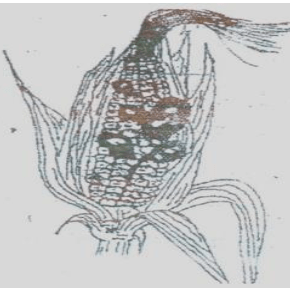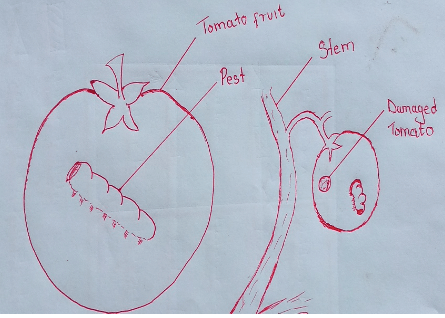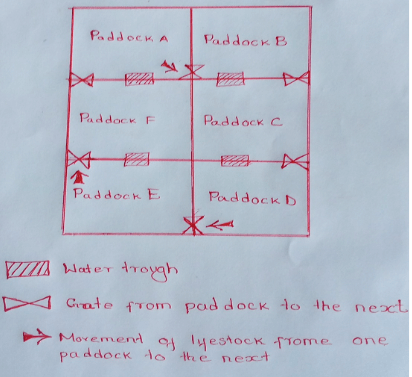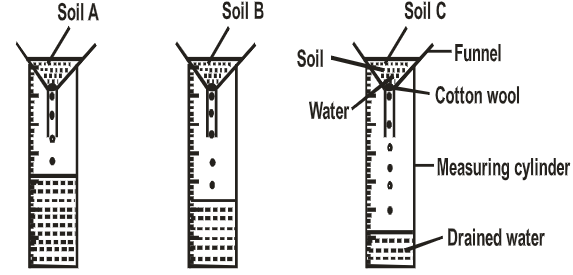Instructions
- This paper consist of three section A, B, and C
- Answer all questions in section A and B
- Answer any two questions in section
SECTION A (30 MARKS)
Answer all question in this section in the space provided
- Name four branches of agriculture. (2 marks)
- Name four soil constituents. (2 marks)
- State four different methods of clearing land before primary cultivation. (2 marks)
- Name four type of pumps used to lift water from its source. (2 marks)
- What are the characteristic of fertile soil? (2 marks)
- State four factors of production. (2 marks)
- Name four elements required by plants in large quantities. (2 marks)
- Name four factors to consider when selecting a nursery site. (2 marks)
- Give four characteristics of a good grain store. (2 marks)
- Name four categories of vegetables (2 marks)
- Name four land reform programs. (2 marks)
- State four type of soil erosion by water. (2 marks)
- Give four methods weed control in a crop farm. (2 marks)
- Name four factors affecting the efficiency of pesticides. (2 marks)
- Name four advantages of silage making. (2 marks)
SECTION B (20 MARKS)
Answer all the questions in this section in the spaces provided
- The diagram below illustrates a maize cob attacked by a disease. Study it carefully and answer the questions that follow.

- Identify the disease. (1 mark)
- Apart from maize give four other crops that may be attacked by the disease. (2 marks)
- State four methods of controlling the disease. (2 marks)
- The diagram below is an illustration a tomato crop pest. Study it and answer the question that follows.

- Identify the pest. (1mark)
- How can a farmer control the pest named in (a) above. (1 mark)
- Name other three minor tomato pest. (3 marks)
- The diagrams below show a set-up of an experiment to study an aspect of soil. Study it and answer the question that follows.
- State the aim of the experiment. (1 mark)
- If the volume of water illustrated in the measuring cylinder was observed after one hour identify the soil sample labeled A and B.
- Soil sample A. (1 mark)
- Soil sample B. (1 mark)
- State two ways in which the soil structure of the sample labeled C above can be improved.(2 marks)
- The diagram below illustrates a grazing system. Study it carefully and answer the question that follows.
 \
\- Identify the grazing system illustrated above (1mark)
- State four advantages of the grazing system illustrated above. (4 marks)
SECTION C (40MARKS)
Answer any two questions in this section in the spaces provided
-
- Describe the cultural methods used to control pest in the farm. (10mks)
- State and explain five biotic factors influencing agriculture. (10mks)
-
- Explain why settlement schemes were established in Kenya soon after independence. (10 marks)
- State the uses of farm records (10 marks)
-
- Explain the factors considered in choosing seed rates (8mks)
- Describe the production of cabbages under the following sub headings
- Nursery establishment and management (6 marks)
- Transplanting (6marks)

MARKING SCHEME
SECTION A (30 MARKS
Answer all question in this section in the space provided
- Name four branches of agriculture. (2 marks)
- Crop production
- Livestock production
- Soil science
- Agriculture economic
- Agriculture engineering
- Crop production
- Name four soil constituents. (2 marks)
- Mineral matter
- Organic matter
- Air
- Water
- Living organism
- State four different methods of clearing land before primary cultivation. (2 marks)
- Tree felling
- Burning
- Slashing
- Use of chemicals
- Name four type of pumps used to lift water from its source. (2 marks)
- Centrifugal / rotardynamic pumps
- Piston / reciprocating pumps
- Semi-rotary pumps
- Hydram pumps
- What are the characteristic of fertile soil? (2 marks)
- Good depth
- Proper drainage
- Good water holding capacity
- Adequate nutrient supply
- State four factors of production. (2 marks)
- Land
- Capital
- Labour
- Management
- Name four elements required by plants in large quantities. (2 marks)
- Carbon
- Hydrogen
- Oxygen
- Nitrogen
- Phosphorus
- Potassium
- Sulphur
- Calcium
- Magnesium.
- Name four factors to consider when selecting a nursery site. (2 marks)
- Nearness to water source
- Type of soil
- Topography
- Previous cropping
- Security
- Well sheltered place
- Give four characteristics of a good grain store. (2 marks)
- Rat or vermin proof
- Well ventilated
- Easy to load and off load
- Pest-freeLeak proof
- Well-secured to minimize theft
- Cool conditions to prevent overheating that would crack the grains
- Name four categories of vegetables (2 marks)
- Leaf vegetables
- Root vegetables
- Fruit vegetables
- Pod vegetables
- Stem vegetables
- Bulb vegetables
- Name four land reform programs. (2 marks)
- Land tenure reform.
- Land consolidation.
- Land adjudication and registration.
- Settlement and resettlement
- State four type of soil erosion by water. (2 marks)
- Splash/raindrop erosion
- Sheet erosion
- Rill erosion
- Gully erosion
- Give four methods weed control in a crop farm . (2 marks)
- Chemical weed control
- Mechanical weed control
- Cultural weed control
- Biological weed control
- Legislative weed control
- Name four factors affecting the efficiency of pesticides. (2 marks)
- Concentration of pesticides
- Timing of application
- Weather conditions at the time of application
- Persistence
- Name four advantages of silage making. (2 marks)
- More nutrients are preserved
- It has few field losses
- It is less dependent on weather conditions
- It can be preserved for prolonged periods with minimum loss of nutrients
- Once ensiled there are no storage problems
- It can be fed directly without liquid additives
SECTION B (20 MARKS)
Answer all the questions in this section in the spaces provided
- The diagram below illustrates a maize cob attacked by a disease. Study it carefully and answer the questions that follow.
- Identify the disease. (1 mark)
- Smuts /ear smut
- Apart from maize give four other crops that may be attacked by the disease. (2 marks)
- Sugarcane,
- wheat,
- sorghum,
- barley,
- oat,
- millet
- Sugarcane,
- State four methods of controlling the disease. (2 marks)
- Plant certified seed
- Crop rotation close season
- Field hygiene/ destroy crop residues
- Hot water
- Rogueing
- Use of resistant variety
- Plant certified seed
- Identify the disease. (1 mark)
- The diagram below is an illustration a tomato crop pest . Study it and answer the question that follow.
- Identify the pest. (1mark)
- American ballworm (Heliothis amigera)
- How can a farmer control the pest named in (a) above. (1 mark)
- By spraying the tomato with insecticides.
- Name other three minor tomato pest. (3 marks)
- Cutworm
- Red spider
- Mite
- nematode
- Identify the pest. (1mark)
- The diagrams below show a set-up of an experiment to study an aspect of soil. Study it and answer the question that follow.
- State the aim of the experiment. (1 mark)
- To compare porosity/ drainage water holding capacity of different soil
- If the volume of water illustrated in the measuring cylinder was observed after one hour identify the soil sample labelled A and B.
- Soil sample A. (1 mark)
- Sandy soil
- Soil sample B. (1 mark)
- Loam soil
- Soil sample A. (1 mark)
- State two ways in which the soil structure of the sample labelled C above can be improved.(2 marks)
- Adding organic matter/ manure
- Liming
- Sub soiling
- Draining away excess water
- State the aim of the experiment. (1 mark)
- The diagram below illustrates a grazing system. Study it carefully and answer the questions that follows.
- Identify the grazing system illustrated above (1mark)
- Paddocking/ rotational grazing
- State four advantages of the grazing system illustrated above. (4 marks)
- Reduce build up of parasite and diseases/prevent spread of parasite and diseases.
- Allows pasture to regrow before being grazed again
- Manure is evenly distributed
- Excess pasture can be conserved
- Allows management practices on ungrazed portions e.g reseeding, fertilizer application/weed control/ irrigation/pest and disease control/cutting back.
- Ensure maximum utilization of pasture.
- Identify the grazing system illustrated above (1mark)
SECTION C (40MARKS)
Answer any two questions in this section in the spaces provided
-
- Describe the cultural methods used to control pest in the farm. (10mks)
- Observing field hygiene
- Destruction of alternate host
- Planting resistance varieties of crops
- Proper land preparation
- Timely planting
- Use of clean planting material
- Practicing closed season
- Crop rotation
- Pruning
- Proper spacing
- Observing field hygiene
- State and explain five biotic factors influencing agriculture. (10mks)
- Pathogens – they cause diseases to livestock, crop causing death of both livestock and crops
- Pest- reduces quality and quantity of agricultural products.
- Pollinators – They aid in pollination thus contributing to the development of new varieties of crops.
- Predator – Animals that prey on others, some help to control pests by feeding on them.
- Nitrogen fixing bacteria – help in fixation of nitrogen in the soil.
- Pathogens – they cause diseases to livestock, crop causing death of both livestock and crops
- Describe the cultural methods used to control pest in the farm. (10mks)
-
- Explain why settlement schemes were established in Kenya soon after independence. (10 marks)
- To transfer land from European to Africans to enable the Africans to own land
- To settle the landless by transferring landless/ squatters to new land allocation.
- To make use of underutilized idle land so as to increase production
- To create employment by working on the farm given to produce crops and keep livestock
- To increase agricultural production through foreign market through exports which earned foreign exchange?
- To ease population pressure on land by transferring people from over populated areas to scarcely populated areas
- State the uses of farm records (10 marks)
- They help to determine the value of the farm in terms of assets and liabilities
- They are used in income tax assessment
- They are used for reference/show history of the farm
- They help in planning and budgeting
- They help to determine the credit worthiness of a farmer
- They help to determine losses and detect theft on the farm
- They assist when sharing profits and losses in partnerships
- They help to settle disputes among heirs
- They help to support insurance claims
- They provide labour information like terminal benefits, NSSF remittances and SACCO dues
- They help in proper management of routine livestock and crop management practices
- They are used to compare the performance of different enterprises in the farm
- Explain why settlement schemes were established in Kenya soon after independence. (10 marks)
-
- Explain the factors considered in choosing seed rates (8mks)
- Number of seeds per hole- When 2 or more seeds are planted per hole, higher seed rate is required than when only one seed is planted per hole
- Spacing- At closer spacing, more seeds are used than at wider spacing
- Germination percentage – less seed id used when its germination percentage is higher. Seed of lower germination percentage is required in larger amounts.
- Seed purity – when planting seed which is pure or with a high germination percentage, less seed is required. More seeds are required wnen using impure /mixed seed.
- Purpose f the crop – crop for silage making is spaced more closely than one meant for grain production. This would require use of more seeds. Maize to be used for silage making requires more seeds than one for grain production
- Describe the production of cabbages under the following sub headings
- Nursery establishment and management (6 marks)
- Site cabbage nursery in an area where Brassica family crops have not grown for the last 3 years
- Prepare nursery bed to fine titlh.
- Remove all roots/ stones/ perennial weeds during preparation
- Make shallow drills 10cm apart and drill in seeds evenly and cover with soil
- Apply mulch and remove when seedlings emerge
- A thin shade is constructed over the nursery
- Water seedlings regularly when dry
- Harden off seedlings 2 weeks before transplanting
- Transplanting (6marks)
- Seedlings are ready for transplanting one month after sowing
- Healthy / vigorously growing seedlings are selected
- Lift seedlings with a lump of soil around the roots
- Water the nursery bed 48 hours before transplanting
- Plant seedlings at the same depth as they were in the nursery
- Firm soil at the base of each seedling
- Transplant early in the morning / late in the evening/ during a cloudy day
- Nursery establishment and management (6 marks)
- Explain the factors considered in choosing seed rates (8mks)
Download Agriculture Paper 1 Questions and Answers - Form 4 Term 1 Opener Exams 2023.
Tap Here to Download for 50/-
Get on WhatsApp for 50/-
Why download?
- ✔ To read offline at any time.
- ✔ To Print at your convenience
- ✔ Share Easily with Friends / Students


